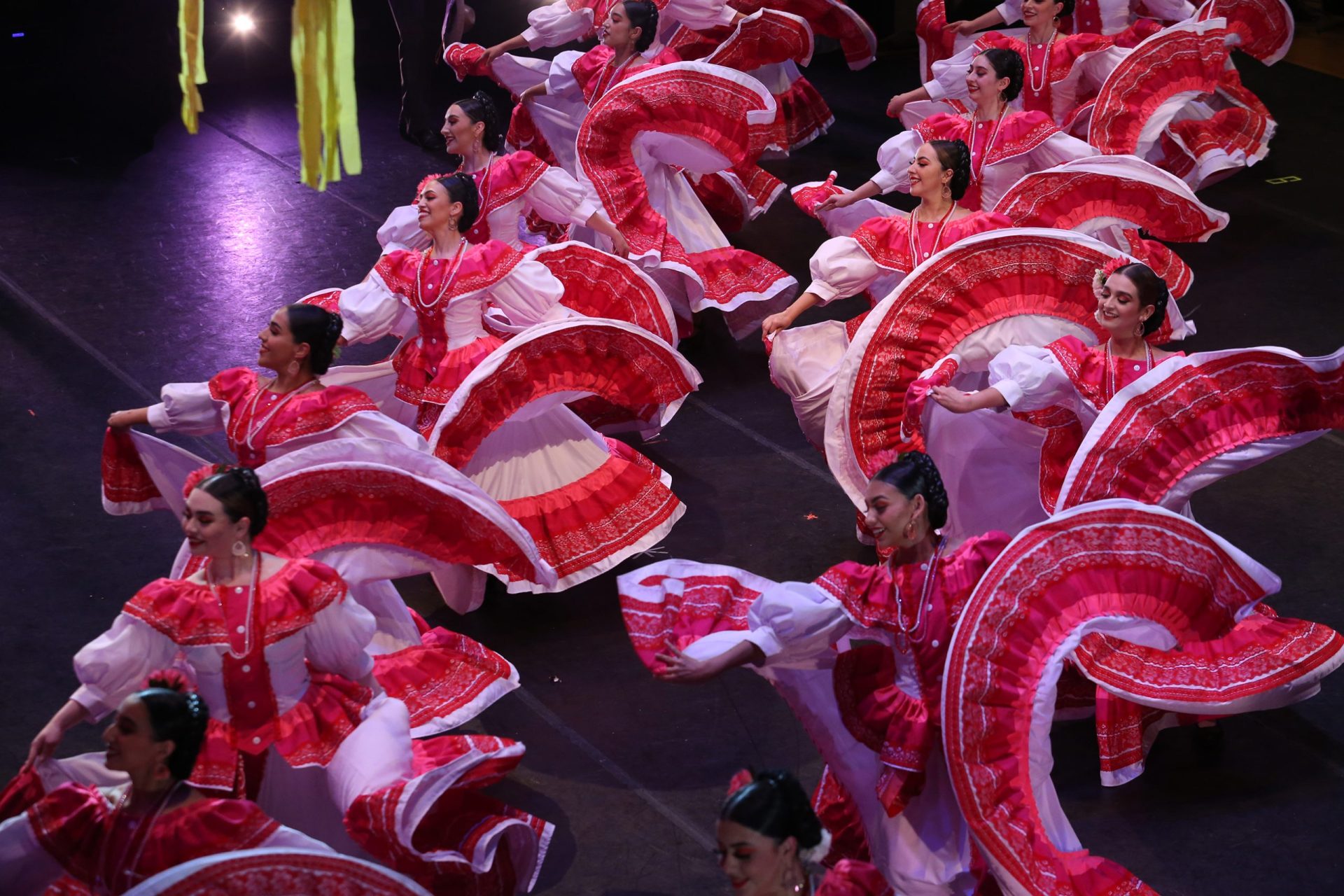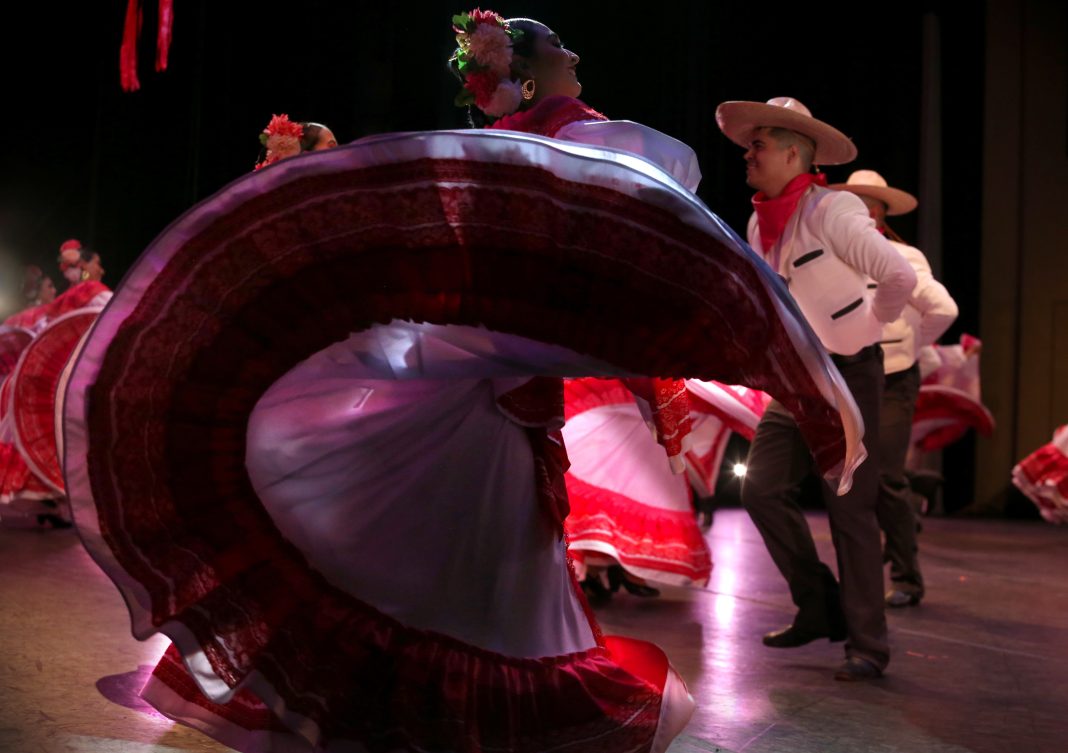EDINBURG — Dancers twirled their way across the stage leaving flashes of red, yellow, green, blue, white and gold streaking through the air as their dresses whipped brilliant colors into the atmosphere, and the crowd cheered.
The music played by the mariachis crescendoed through the auditorium, adding an extra spark to the lively performance.
These were but a few of the vibrant sights Friday here at the University of Texas Rio Grande Valley Performing Arts Complex in Edinburg, where performers kicked off their annual Alegría show.
For Miguel Pena Caballero, director of the UTRGV Ballet Folklorico, this show gives him the opportunity to represent Mexican culture through choreographed dances specific to certain regions of Mexico.
“Alegría is just a journey through Mexico,” Caballero said. “We take the audience through several states in Mexico presenting several regions.”
This year’s show included a prehispanic dance and various dances representing Sinaloa, Baja California, Colima, Tabasco, Veracruz and Huasteca Veracruzano.
This means seven regions are represented in the 2023 edition of Alegría as opposed to six regions as in the past. Performers, including 40 dancers and 20 musicians, start practicing in mid-August and rehearse about twice a week for three hours each day.
Caballero explained that every year about 50% of the show is changed to give audiences something different. In fact, the regions that are represented in the performances are selected a year in advance.
Not only are traditional dances presented in the show but the costumes used by the dancers also add authenticity to the performance.
“Everything that is being used in the show was made in Mexico,” Caballero explained, adding that each of the costumes are hand-crafted in the specific state being represented. “Everything is traditional. Everything is really close to what the traditional costume is in that state.”

Valerie De Leon, 20, who has been a dancer in Alegría for the past three years, spoke with enthusiasm Friday in describing what she enjoys about the performances.
“Our last dance, Sinaloa, is probably my favorite,” De Leon said with joy in her voice. “It’s like a wedding thing and I just think that the dresses are really pretty, the skirt work. Everything is just really lively and festive.”
Although the show is full of color and flair, she explained that it is not just a colorful performance but rather a “dance show that shows tradition.”
Prior to each dance, the audience is provided with a quick narration that describes the costumes, traditions, or culture of the specific state they will be representing.
“We want not only to entertain people, we also want to educate and inform people,” Caballero said.
To further add to the traditionalism of the culture represented in Alegría, this year’s show also included performances by the UTRGV Mariachi Juvenil Azatlan and Grupo Galan, a Conjunto and Norteño band.
“Almost the whole show is going to be live music,” Caballero said.
According to Dahlia Guerra, co-director of the music in Alegría, the show is a collaboration between the dancers and the mariachi music.
In fact, this year’s show incorporated the mariachi for the first time in the Huasteca Veracruzana dance number.
For dancer Juan Jose Gonzalez, 22, the addition of the mariachi to this dance “took it to the next level.”
“Huasteca Veracruzana — that’s my favorite (dance) and this year we’re doing it with live music. So we’re collaborating with the mariachi and it just took it to the next level,” he said. “It sounds beautiful with the harp and everything.”
Guerra concurred.
“It’s enjoyable because there is so much variety and the dancers are so wonderful, the musicians are wonderful and it just represents our community and our Hispanic heritage,” Guerra said.
She added that although every region has a different sound and dance her favorite musical piece from this year’s show is the Huastecan numbers.
This year the music included violin pieces to represent music from areas such as Jalisco.
“They’re all different in their own way,” Guerra said. “They have different styles of music, of playing and different instruments are highlighted.”
Dancers such as Maria Garcia, a 22-year-old Alegría performer for the last three years, and 19-year-old Alejandra Ramos, found representation in the performances that created a sense of pride in Hispanic heritage.
“I was born here but I grew up in Mexico, so for me it means a lot to represent Mexico and the cultures because it comes from my roots,” Garcia said, adding that her favorite costumes this year are the ones used in Colima and Veracruz.
Ramos considers Alegría an opportunity to tell a history to be proud of.
“It makes me very proud because dance is such a beautiful art form and to tell the history and culture of Mexico, it’s just so beautiful to see that,” Ramos said.
The show will be hosted through Sunday and again next weekend from Friday to Sunday, Feb. 10-12. Performances are scheduled for 7:30 p.m. Friday and Saturday and 2 p.m. Sunday.
Tickets can be purchased at utrgv.edu/arts and are $15 for adults, $10 for senior citizens and students, and $5 for kids.
To see more, view Monitor photojournalist Delcia Lopez’s full photo gallery here:
Photo Gallery: Let’s Dance! UTRGV Ballet Folklorico debuts new regions for Alegría 2023




